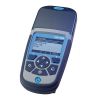Hach SpecCheck Secondary Gel Standards Set
Features
- Check instrument response without sample or reagent preparation
- Colored gels are stable, assuring consistent performance
- 2-year guaranteed performance
- Free ground shipping
- Expedited repair and warranty service
- Lifetime technical support
- More
Overview
The Hach SpecCheck Secondary Gel Standards Set includes four 10-mL (1-inch) vials filled with gels that simulate the test color at various chlorine concentrations, instructions, a plastic case and a Certificate of Analysis. SpecCheck Standards are computer-formulated and have a two-year shelf life from the date of manufacture.
Benefits
- Use with Hach Colorimeters and Spectrophotometers
- Solid Gel Standards - No preparation required
- Ideal for instrument verification in the lab and in the field
- 2-year guaranteed performance
- NIST traceable
- (4) 10 mL (1-inch) sealed glass cells
- (3) Standards and a blank
- (1) Certificate of analysis
- (1) Instructions
- (1) Plastic case
In The News
Wisconsin watershed program involves high schools to collect, share data
A group of high schoolers in the Green Bay, Wisc. area are learning about careers in environmental science thanks to the Lower Fox River Watershed Monitoring Program. The program, supported by the University of Wisconsin, has involved more than 700 students since its 2003 launch. “We have almost ten years of data,” said Annette Pelegrin, program coordinator. “It began in 2003 with five watersheds. We’ve trained teachers and schools that are interested and showed them how to measure different parameters.” Those include flow, temperature, transparency and turbidity of the program’s streams. YSI 55 meters are used to measure dissolved oxygen and levels of phosphorus, ammonia and nitrogen are checked with a Hach colorimeter.
Read MoreOhio city sleuths for illegal discharges to streams
Springfield, Ohio, a college town of 60,000 in southwestern Ohio, sits on the confluence of the Mad River and Buck Creek. Springfield’s streams are as much a part of the city as is Wittenberg University. The streams and the university’s brick infrastructure stand as a constant backdrop to the action of the community but do not often draw attention themselves. Over the next year, however, Springfield will be paying close attention to its waterways in an effort to eliminate illegal discharges. “The city is required to determine the location of every pipe that enters Springfield’s streams,” said Sky Schelle, the stormwater coordinator for the city of Springfield. “If a pipe is flowing, we must determine the source of the flow.
Read MoreFloating Global New Ideas: Buoy-Enabled Research at Florida Agricultural and Mechanical University’s School of the Environment
Florida Agricultural and Mechanical University (FAMU), based in Tallahassee, Florida, is the highest-rated public Historically Black College or University in the United States. FAMU’s School of the Environment (FAMU-SOE) offers BS and BA degrees in Environmental Studies, and BS, MS, and Ph.D. degrees in Environmental Science, with specialisms available in areas including Environmental Policy and Risk Management, Aquatic and Terrestrial Ecology, and Biomolecular Sciences. In 2021, FAMU-SOE deployed a NexSens CB-450 buoy in Apalachee Bay, a key oyster farming area around 30 miles south of Tallahassee. The buoy has quickly been incorporated into the curriculum, providing environmental insights for student research, the community, and beyond. Dr.
Read More








